How to Make Sacher Torte

Yes, yes Gerhard, I know: Sacher-style torte. No one outside the Sacher and/or Demel enterprises knows the actual recipe. However I believe this formula to be quite close. It’s certainly close to what I remember. In fact in some ways I think this is closer to what I ate in Vienna twenty five years ago than the most current photographs I’ve seen of “original” Sacher torte, for indeed lately it appears to me that the layer of chocolate on the exterior of the official tortes has gotten quite, quite thick. Is it my imagination? It could well be. I like a thinner glaze, however below I’ll tell you how to make a thick one if you wish.
Start by preparing your springform pan (directions under How to Prepare a Pan for Baking in the Techniques menu), then melting the chocolate for your batter. Allow the chocolate to cool while you get everything else ready.
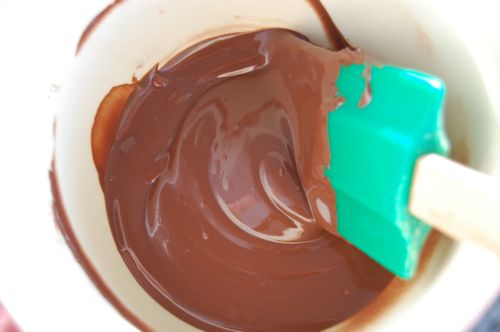
As I mentioned previously, a Sacher torte batter is a combination of three components: sifted flour, meringue and a chocolate “mayonnaise” which we shall now prepare. Put your butter and 1/4 cup of the sugar in the bowl of a stand mixer fitted with a paddle:
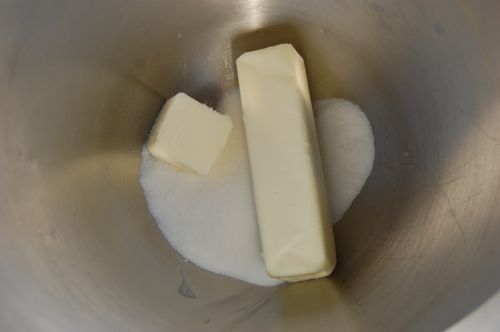
Beat until creamy and light in color…
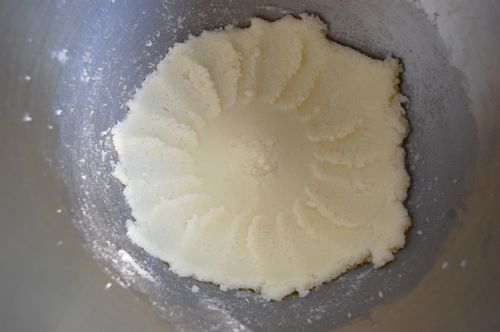
…then switch to the whip. Add the room-temperature egg yolks one by one, then finally the whole egg. The mixture may look a little rough — not totally smooth — that’s OK. Scrape the sides down.
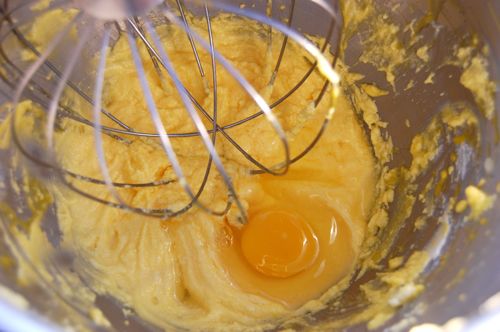
Start drizzling in the melted chocolate. Ooops…that’s more than a drizzle. No matter.
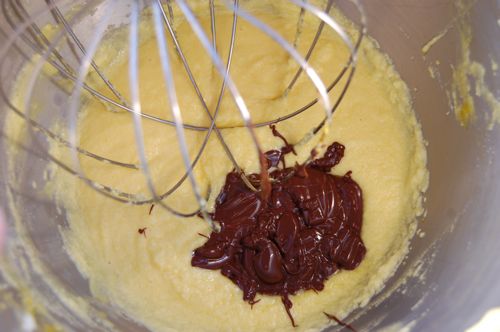
It’ll still whip up just fine. Scrape the sides of the bowl and whip a bit more to make sure everything is incorporated. Set this mixture aside in a large bowl and wash and dry the mixer bowl and whip.
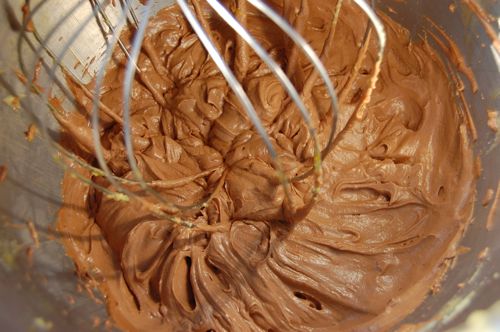
Wash and dry the implements thoroughly, because the next step will be whipping up your egg whites and you don’t want any residual fat left in there. Place your room-temperature egg whites in the bowl and begin whipping.
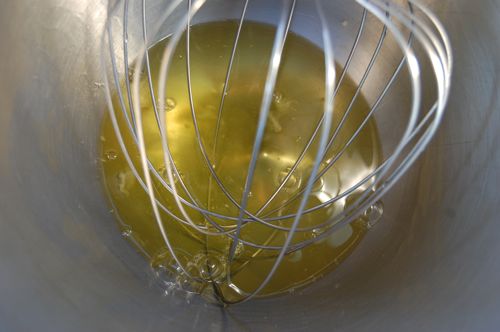
You’ll want them voluminous — around about the soft peak stage — before you start adding in the rest of your sugar.
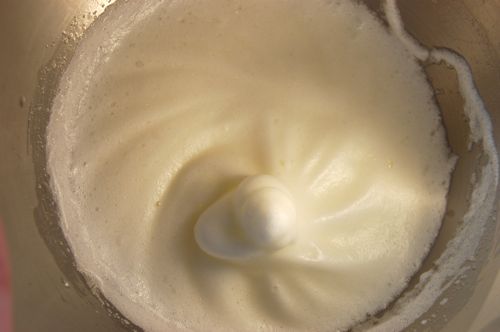
Slowly pour the sugar in with the machine running. Whip about 30 seconds or so until you have a nice, glossy meringue.
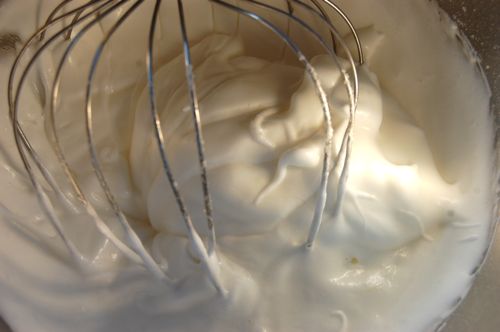
With the three base components prepared, it’s time to start folding. The idea is to alternate the meringue and sifted flour until everything is incorporated. Start by adding about a third of the meringue and fold until just a few streaks remain.

Sprinkle on a few spoonfuls of the flour and keep going.

As you get closer to using up all your ingredients, you’ll notice the mixture becoming thicker and more batter-like. Fold until just a few small streaks remain.
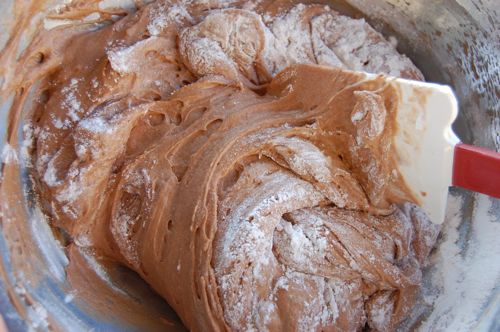
Pour into your prepared pan and insert on the bottom shelf of a 300 oven. Prop the door open slightly by inserting the handle of a wooden spoon in the door. This will help ensure that the top doesn’t “dome” too much in the oven. Bake for 15 minutes, then remove the spoon and bake about 45 minutes more, until the middle feels springy to the touch. Cool on a wire rack. At this point the cake cake sit in the pan — uncovered — overnight if you wish.

Of course it will dome somewhat. That dome will collapse a bit as the finished cake cools. It’ll look about like this.
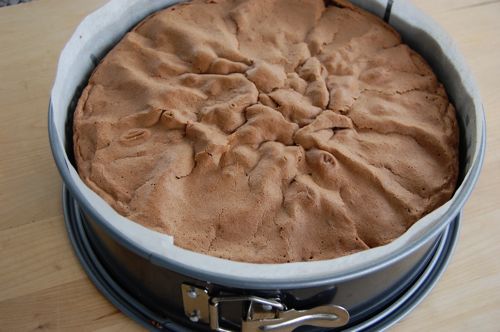
That’s an unsightly top for a refined torte. The good news is it can be easily trimmed off. Remove the ring of the springform pan and break out your best serrated knife. (Save those scraps for your upcoming coffee break).
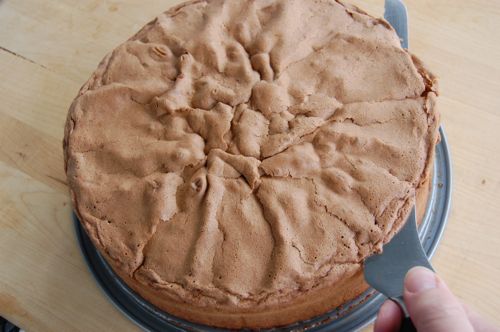
While you’re cutting, carefully slice the cake in two horizontally (this is where you’ll put the apricot filling shortly).
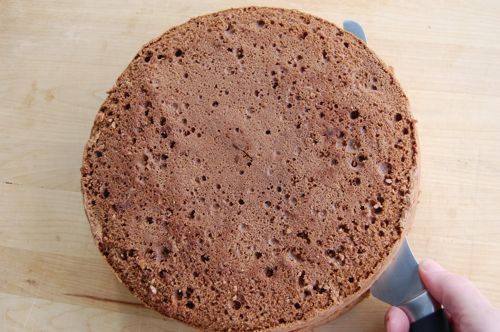
Now to get the cake ready for assembly. Place a sheet of parchment on top of the cake and flip the whole works over, pan bottom and all.

Remove the pan bottom and the parchment liner.
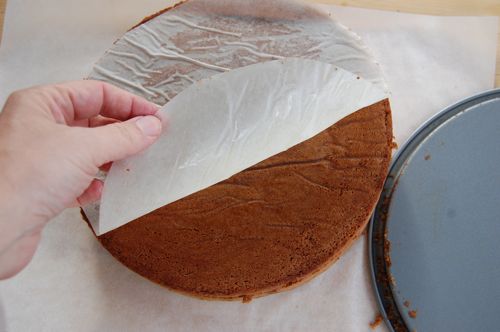
Place a 9″ cardboard cake round (waxed side down) on the layers.
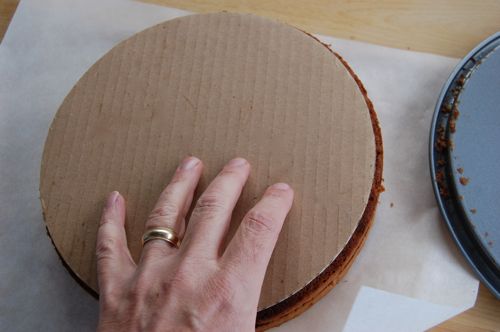
Flip the stack over again onto a sheet pan fitted with a wire rack. Take off the top layer and slather on some of your warmed, puréed apricot preserves.

Replace the top layer and enrobe the whole thing in preserves. And then it’s coffee break time. Linger over your cake scraps and a nice hot cup for at least half an hour. If you wish, you can let the torte sit in the fridge, uncovered, for a day or more before applying the chocolate glaze.
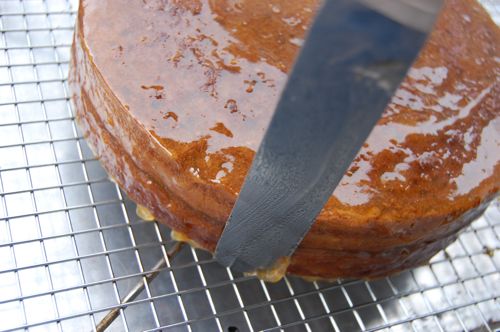
To make the glaze put the sugar and water in a small saucepan, preferably taller than it is wide. You don’t want too much evaporation while you “cook” your chocolate glaze, lest the chocolate solids start to burn.

When the sugar syrup starts to boil, pour in your chopped chocolate and stir until melted. Heat the whole mixture to 234 degrees Fahrenheit. What’s being made here is a sort of chocolate candy.
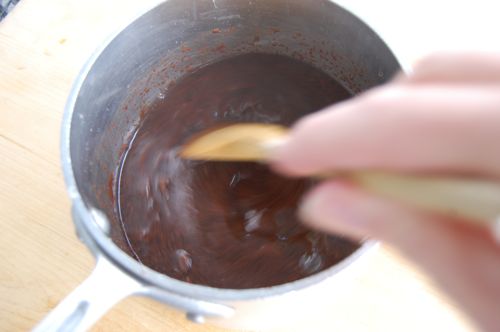
When the target temperature is reached, remove the pan from the heat and let it cool down. This will take some time. Mine took half an hour just to get to 170. You’ll want to stir it a touch every now and again to keep a skin from forming, but not too much.
Because of all the sugar, the syrup will start to thicken quit a bit at around the 150 point. You can pour it sooner or later according to your taste — a thicker texture will translate to a thicker coating. What you don’t want it is a texture that’s so thick you have to spread it with a spatula. That will ruin the even coating. So if you find it getting too thick, it’s not against the rules to apply a little more heat to loosen it up.

When ready, just pour the glaze on, directing it a little bit this way and that with your spatula. I know what you’re thinking: won’t that warm glaze just melt the apricot jam right off? The answer is no, it’ll go on like molten lava, and while the jam will soften, it won’t have time to run.
When you’re done pouring, there will be some glaze left in the pan, but don’t scrape it off. It’ll be partly solidified and will make your coating lumpy-looking. Let the torte sit on the wire rack for about 15-20 minutes to firm up, then gently pry it up with a spatula. Supporting the torte on the palm of your hand, trim off the excess glaze and place it on the platter of your choice. Let sit for a minimum of four hours before slicing and serving, preferably overnight.
Serve with a generous spoonful of — of course — lightly sweetened whipped cream.
hi
itsvery good cake
but very hard making it
yhank u
left a question have not a clue where, definately not under the correct heading, thats for sure………………… would a ganache type glaze by adding cream to the chocolate work?
Yes, Ali, it does work just fine. I have instructions for making ganache under the Pastry Components menu.
Good luck!
– Joe
Joe, Thanks very much for the reply, have only discovered your site and wish I had found it years ago, its now going to give me the confidence to try bigger and bolder receipes knowing that should I need anything explained Joe Pastry will have the answer.
Now only need to discover a site that explains cooking techniques/skills and life will be perfect !!
Ali, those are wonderful things to say and I deeply appreciate them. Please get in touch if I can shed any additional light on anything you find here. In the meantime happy baking!
– Joe
Made with a ganache glaze………..mmmmmmmmmmmm
Worth the effort for the finished result, stunning is all I can say, tasted exactly how I remembered, infact better.
1st tasting was over 30 years ago and just a delicious memory, however, relived the memory with equally receptive tastebuds and had the added bonus of a whole cake not merely a portion, bliss.